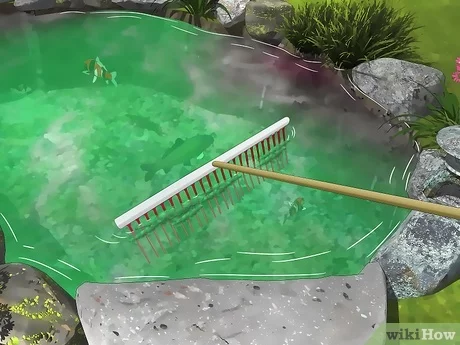Algae growth in ponds is a common issue that many pond owners face. While algae are a natural part of the pond ecosystem, excessive algae can lead to imbalances in the water quality and harm the fish living in the pond. In this article, we will discuss effective methods to remove algae from a pond without harming the fish.
Understanding Algae in Ponds
Algae are simple aquatic plants that can grow rapidly in the presence of sunlight and nutrients in the water. There are different types of algae, including green algae, blue-green algae, and string algae. While some algae are beneficial for the pond ecosystem, excessive algae growth can lead to oxygen depletion and harm fish and other aquatic life.

Credit: www.youtube.com
Methods to Remove Algae
When dealing with algae in a pond, it is essential to choose methods that effectively control algae growth while ensuring the safety of the fish in the pond. Here are some methods to remove algae from a pond without harming the fish:
1. Manual Removal
One of the simplest ways to remove algae from a pond is through manual removal. Use a pond net or rake to skim the algae from the surface of the water. Be gentle to avoid disturbing the fish and other aquatic life in the pond.
2. Barley Straw
Barley straw is a natural and effective way to control algae in ponds. Place barley straw bales or pellets in the pond, where they will gradually decompose and release compounds that inhibit algae growth. Barley straw is safe for fish and other aquatic life.
3. Beneficial Bacteria
Beneficial bacteria products contain natural bacteria strains that help break down organic matter in the pond, including excess algae. These bacteria products are safe for fish and other aquatic organisms and can help maintain a healthy pond ecosystem.
4. Aeration
Aeration can help improve water circulation and oxygen levels in the pond, which can inhibit algae growth. Installing an aerator or fountain can create a more oxygen-rich environment that is less conducive to algae growth while benefiting the fish in the pond.
5. Shade Plants
Planting shade plants around the pond can help reduce sunlight exposure to the water, limiting algae growth. Shade plants not only enhance the aesthetic appeal of the pond but also provide a natural way to control algae without harming the fish.
6. Uv Clarifiers
UV clarifiers use ultraviolet light to kill algae cells in the water, preventing algae blooms. UV clarifiers are safe for fish and other aquatic life and can be an effective method to control algae in ponds without the use of chemicals.
7. Pond Dye
Pond dye can be used to shade the water and reduce sunlight penetration, limiting algae growth. Choose a non-toxic pond dye that is safe for fish and other aquatic organisms to maintain a healthy pond environment.

Credit: www.wikihow.com
Tips for Maintaining a Healthy Pond
In addition to controlling algae growth, here are some tips to help maintain a healthy pond ecosystem:
- Regularly test the water quality and monitor nutrient levels in the pond.
- Avoid overfeeding fish, as uneaten food can contribute to algae growth.
- Remove debris and fallen leaves from the pond to prevent nutrient buildup.
- Perform partial water changes to dilute nutrients and maintain water quality.
- Introduce aquatic plants that compete with algae for nutrients and provide natural filtration.
Conclusion
Algae growth in ponds can be managed effectively using natural methods that do not harm the fish and other aquatic life in the pond. By following the methods and tips outlined in this article, pond owners can maintain a healthy and balanced pond ecosystem while keeping algae growth in check.
Remember, a healthy pond is not only beneficial for the fish but also enhances the overall beauty and tranquility of your outdoor space. With proper maintenance and care, you can enjoy a vibrant and algae-free pond for years to come!





